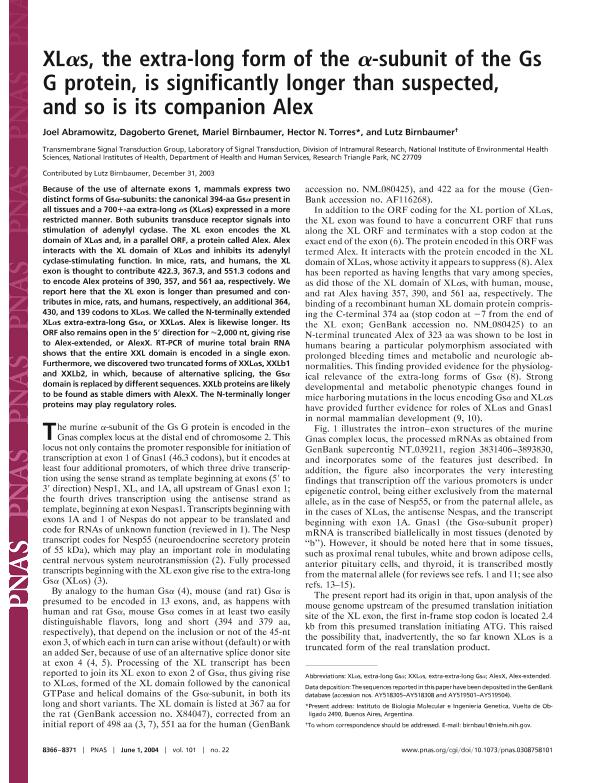Mostrar el registro sencillo del ítem
dc.contributor.author
Abramowitz, Joel
dc.contributor.author
Grenet, Dagoberto
dc.contributor.author
Birnbaumer, Mariel
dc.contributor.author
Torres, Hector Norberto

dc.contributor.author
Birnbaumer, Lutz

dc.date.available
2019-07-17T17:53:11Z
dc.date.issued
2004-06
dc.identifier.citation
Abramowitz, Joel; Grenet, Dagoberto; Birnbaumer, Mariel; Torres, Hector Norberto; Birnbaumer, Lutz; XLαs, the extra-long form of the α-subunit of the Gs G protein, is significantly longer than suspected, and so is its companion Alex; National Academy of Sciences; Proceedings of the National Academy of Sciences of The United States of America; 101; 22; 6-2004; 8366-8371
dc.identifier.issn
0027-8424
dc.identifier.uri
http://hdl.handle.net/11336/79749
dc.description.abstract
Because of the use of alternate exons 1, mammals express two distinct forms of Gsα-subunits: the canonical 394-aa Gsα present in all tissues and a 700+-aa extra-long αs (XLαs) expressed in a more restricted manner. Both subunits transduce receptor signals into stimulation of adenylyl cyclase. The XL exon encodes the XL domain of XLαs and, in a parallel ORF, a protein called Alex. Alex interacts with the XL domain of XLαs and inhibits its adenylyl cyclase-stimulating function. In mice, rats, and humans, the XL exon is thought to contribute 422.3, 367.3, and 551.3 codons and to encode Alex proteins of 390, 357, and 561 aa, respectively. We report here that the XL exon is longer than presumed and contributes in mice, rats, and humans, respectively, an additional 364, 430, and 139 codons to XLαs. We called the N-terminally extended XLαs extra-extra-long Gsα, or XXLαs. Alex is likewise longer. Its ORF also remains open in the 5′ direction for ≈2,000 nt, giving rise to Alex-extended, or AlexX. RT-PCR of murine total brain RNA shows that the entire XXL domain is encoded in a single exon. Furthermore, we discovered two truncated forms of XXLαs, XXLb1 and XXLb2, in which, because of alternative splicing, the Gsα domain is replaced by different sequences. XXLb proteins are likely to be found as stable dimers with AlexX. The N-terminally longer proteins may play regulatory roles.
dc.format
application/pdf
dc.language.iso
eng
dc.publisher
National Academy of Sciences

dc.rights
info:eu-repo/semantics/openAccess
dc.rights.uri
https://creativecommons.org/licenses/by-nc-sa/2.5/ar/
dc.subject.classification
Bioquímica y Biología Molecular

dc.subject.classification
Ciencias Biológicas

dc.subject.classification
CIENCIAS NATURALES Y EXACTAS

dc.title
XLαs, the extra-long form of the α-subunit of the Gs G protein, is significantly longer than suspected, and so is its companion Alex
dc.type
info:eu-repo/semantics/article
dc.type
info:ar-repo/semantics/artículo
dc.type
info:eu-repo/semantics/publishedVersion
dc.date.updated
2019-07-16T14:13:25Z
dc.journal.volume
101
dc.journal.number
22
dc.journal.pagination
8366-8371
dc.journal.pais
Estados Unidos

dc.journal.ciudad
Washington
dc.description.fil
Fil: Abramowitz, Joel. National Institutes of Health; Estados Unidos
dc.description.fil
Fil: Grenet, Dagoberto. National Institutes of Health; Estados Unidos
dc.description.fil
Fil: Birnbaumer, Mariel. National Institutes of Health; Estados Unidos
dc.description.fil
Fil: Torres, Hector Norberto. Consejo Nacional de Investigaciones Científicas y Técnicas. Instituto de Investigaciones en Ingeniería Genética y Biología Molecular "Dr. Héctor N. Torres"; Argentina. National Institutes of Health; Estados Unidos
dc.description.fil
Fil: Birnbaumer, Lutz. Consejo Nacional de Investigaciones Científicas y Técnicas. Instituto de Investigaciones en Ingeniería Genética y Biología Molecular "Dr. Héctor N. Torres"; Argentina. National Institutes of Health; Estados Unidos
dc.journal.title
Proceedings of the National Academy of Sciences of The United States of America

dc.relation.alternativeid
info:eu-repo/semantics/altIdentifier/url/https://www.ncbi.nlm.nih.gov/pmc/articles/PMC420400/
dc.relation.alternativeid
info:eu-repo/semantics/altIdentifier/doi/http://dx.doi.org/10.1073/pnas.0308758101
dc.relation.alternativeid
info:eu-repo/semantics/altIdentifier/url/https://www.pnas.org/content/101/22/8366
Archivos asociados
